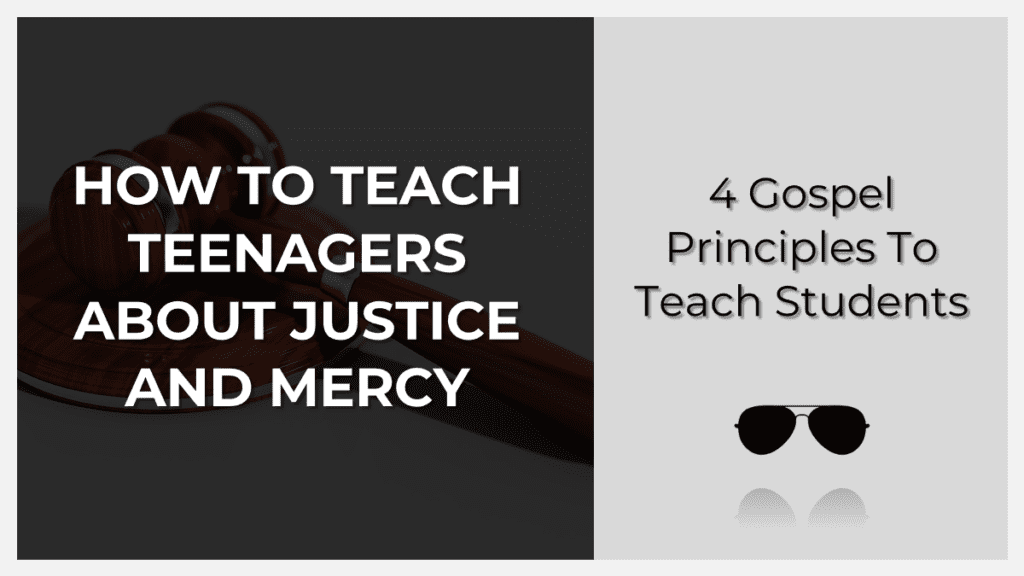
10 Youth Group Games You Can Play with Just a Kickball
Everyone loves games. Games can start connections with your group. As youth pastors, we want to make the time to

Justice is one of the most talked-about issues in today’s world. Students are hearing about fairness, activism, and systemic injustice almost daily—from social media, news cycles, and conversations at school. Many care deeply about these topics, but they don’t always know how their faith should shape the way they respond. The good news is the Bible has a lot to say about justice and mercy—and not just as cultural ideas, but as core elements of what it means to live a gospel-shaped life. So let’s talk about some ways to teach teenagers about justice and mercy.
When you ask students to define justice, you’re likely to hear things like “fairness,” “getting what you deserve,” or “making things right.” While those aren’t entirely wrong, they’re also incomplete. Biblical justice is more than a social construct. Biblical justice reflects God’s own character. Psalm 89:14 tells us that righteousness and justice are the foundation of God’s throne, meaning these aren’t just optional values. They’re central to who He is.
The Bible also connects justice to mercy. In Micah 6:8, God calls His people not only to do justice, but to love kindness and walk humbly. This reminds us that biblical justice isn’t only about punishment—it’s about restoring what’s been broken. When teaching this, invite students to explore how cultural definitions of justice compare to the ones we see in Scripture. Help them see that justice, in God’s kingdom, always travels with grace.
There’s no clearer picture of justice and mercy working together than the cross. In Jesus, we see God’s justice on full display. Sin is taken seriously, and the penalty is paid. But we also see God’s mercy on full display in the gospel in that Jesus takes our place and we receive forgiveness. The gospel doesn’t pit justice and mercy against each other; it holds them in perfect tension.
Students today hear about fairness, activism, and systemic injustice almost daily. Many care deeply about these issues (it’s no stereotype – studies confirm Gen Z is “passionate about equality and justice of every kind”), but they don’t always know how their faith should shape their response. The good news is that the Bible has a lot to say about justice and mercy – not just as cultural ideas, but as core elements of living a gospel-shaped life. So when you teach on justice and mercy, you’re tapping into something students already care about, and showing how God’s heart for justice meets the world’s needs with grace.
Justice isn’t just a trend or a cause—it’s part of what it means to follow Jesus. Because we’ve received mercy, we’re called to extend mercy. Because we worship a just God, we’re called to seek justice in the world around us. When students start to understand that connection, justice becomes more than just a buzzword—it becomes a way of life rooted in grace.
It’s easy for students to associate justice with activism, protests, or policy change. And while those things matter, Scripture consistently brings justice down to ground level—how we treat the people right in front of us. For a teenager, that might mean defending someone being bullied, choosing forgiveness over retaliation, or making space for someone who’s left out.
Encourage your students to look at the relationships and situations in their daily lives where injustice shows up. What would it look like to respond with both conviction and compassion? Teach them that biblical justice isn’t just something we post about—it’s something we live out in the way we speak, serve, and love others.
If students want to follow Jesus, they need to care about what He cares about. Jesus consistently stood with the marginalized, spoke truth to power, and extended mercy to the broken. But He never did those things in isolation—He did them together. Justice without mercy can be cold. Mercy without truth can be soft. But justice paired with mercy reflects the heart of the gospel.
Your role as a leader is to help students live in that tension. Invite them to speak up for what’s right and also to forgive when they’ve been wronged. Help them see that being faithful in small things—how they treat classmates, how they use their influence—matters deeply to God.
Teenagers are already thinking about justice. The question is whether they’ll approach it through the lens of culture or through the lens of the gospel. When we show them that justice isn’t just about punishment—it’s about restoration—and that mercy isn’t weakness but strength, we invite them into a bigger, more compelling story. In that story, they don’t just care about what’s trending. They start to care about what God cares about.
Related Posts:
How to Teach Teenagers About Serving Others & Generosity
How to Teach Teenagers About The Role of the Church in Their Lives
Check out GP – A sermon series on justice, privilege, and the gospel’s vision for community.
For help choosing a gospel-centered curriculum that supports your teaching on justice and mercy, explore our guide to choosing the best youth ministry curriculum for your church.

Everyone loves games. Games can start connections with your group. As youth pastors, we want to make the time to

Most of us don’t get into youth ministry for the overwhelmingly generous paycheck. We love Jesus, we love the next

The Trinity is one of the most foundational doctrines in Christianity—and one of the most confusing. How can God be